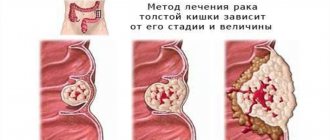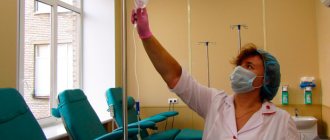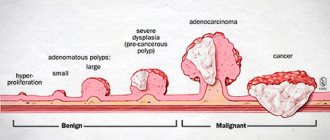The rectum is the most terminal section of the digestive tube. It is a continuation of the large intestine, but in its anatomical and physiological features it differs significantly from it.
The fact that a pathological process is taking place in the final section of the intestinal tube is indicated by the appearance of polyps, adenomas, and inflammatory foci. , rectal cancer develops against their background . Treatment for this disease is usually successful, as the disease has been well studied. Even if it is neglected, a cure is possible if the therapy is carried out by qualified experienced oncologists.
According to world statistics, almost 800 thousand people are diagnosed with colorectal cancer every year. It ranks 4th in the global ranking of cancer diseases.
The disease most often occurs in patients living in developed countries. Their stable economy leads to a decrease in people's physical activity, and this leads to a high risk of developing obesity - and, as a result, to colon cancer. For example, in the USA, 145 thousand people are diagnosed with colorectal cancer every year.
In Belarus, rectal cancer most often affects men and people over 45, especially after 75 years.
Rectal cancer - what is it?
This malignant cancer originates from the epithelium of the rectum. This tumor has the characteristic features of any malignant formation - rapid growth, invasion of neighboring tissues, metastasis.
Men and women are equally susceptible to the disease. An increase in the number of cases is observed from the age of 45, and the peak incidence occurs among 75-year-olds.
Symptoms
Blastoma can easily be completely cured, but only if it can be diagnosed at the beginning of its development. The main problem is that malignant neoplasms at the initial stage of formation may not show any signs.
The only thing that can accompany the pathological process is an increase in temperature, general weakness, increased fatigue and decreased performance.
However, the listed symptoms may also indicate other, less serious processes.
Intestinal blastoma
Blastoma is a pathology of a malignant nature, characterized by the rapid growth of a tissue structure consisting of infected, damaged cells.
As the cancer progresses, the first clinical signs begin to appear, including:
- rapid weight loss;
- pain during bowel movements;
- bowel dysfunction in particular, constipation may be replaced by diarrhea;
- darkening of stool;
- lack of iron in the human body.
General intoxication is also observed, which is accompanied by dizziness, attacks of nausea and vomiting, headaches, and increased sweating.
About the disease
The mucous membrane of the final portion of the colon is covered with columnar epithelium with a large number of glands. Their cells produce mucus. Under the influence of risk factors, pathological cells appear with uncontrolled division and loss of the apoptosis mechanism - programmed death. Gradually, a tumor of the rectum is formed from them.
Presumably the causes of rectal cancer have been established:
- Poor nutrition. The predominance of meat foods and animal fats in the diet with a simultaneous deficiency of plant fiber impairs the passage of feces, contributes to constipation and the development of colorectal tumors.
- The role of heredity has been noticed in the occurrence of certain forms of neoplasms.
- Precancerous pathologies - polyps, Crohn's disease, ulcerative colitis.
- Immunodeficiency conditions, carcinoma of the genital organs or breast in women.
Causes
Before talking about predisposing factors that can trigger the development of the disease, it is necessary to clearly understand the mechanism of its development. The formation of tumor formation is facilitated by the appearance of atypical cells, that is, with altered DNA in them.
Pleuropulmonary blastoma in children
In children, neoplasms of various types are diagnosed less frequently than in adults.
When the immune system is weakened and cannot cope with the changed cells, they divide. This is how the development of the tumor is characterized.
Thus, the formation of atypical cells can be for several reasons:
- high concentration of pathological cellular structures in the body;
- weakened immunity;
- forced production of new cells by the body.
The factors listed above can be triggered by the negative effects of chemical and physical carcinogens. This group includes prolonged contact with pesticides, excessive uncontrolled use of certain groups of medications, poor nutrition, radiation, and physical stress on a specific organ.
The development of rectal blister can primarily be caused by poor diet. If animal fats predominate in the diet, the risk of disease increases.
Other reasons include excess body weight, abuse of beer, and lack of fresh plant foods on the menu.
Hereditary predisposition also plays an equally important role. It does not matter whether either parent was diagnosed with intestinal blastoma. Any oncological tumor can provoke the appearance of disease in the rectum.
Types of rectal cancer
The type of tumor is determined by its location:
- Anorectal location is typical for 5-8% of cases.
- Ampullary occurs more often than others, up to 80%. This is a pathology in the widest part of the intestine.
- Supraampullary localization in up to 12% of patients.
The nature of tumor growth can be:
- exophytic – grows into the intestinal lumen;
- endophytic - grows through the thickness of the wall, infiltrates it, and can cover it circularly;
- mixed growth.
According to the histological picture, the neoplasm can be:
- glandular cancer (adenocarcinoma);
- solid;
- signet ring cell;
- skirr;
- squamous.
Symptoms of colorectal cancer, first signs
Discussing rectal problems is something shameful for many people. Therefore, the first signs of pathology often remain without due attention. The initial symptoms of rectal cancer are changes in stool character. Frequent changes in constipation and diarrhea appear, and the shape of stool changes. It becomes much thinner than before. The feeling of incomplete defecation, discomfort, and increased formation of gases are disturbing.
The development of the tumor process causes long-term signs of rectal cancer:
- mucus and blood in stool;
- purulent discharge;
- feeling of fullness in the intestines;
- bloating;
- pain in the rectal area;
- chronic fatigue, fatigue;
- anemia;
- weight loss.
In the initial stages, there may be no manifestations of the disease. If anemia of unknown origin is detected, it is worth looking for the cause of hidden bleeding. Perhaps it's cancer.
Late stages are characterized by damage to other organs:
- germination into neighboring organs, formation of interorgan fistulas;
- purulent-inflammatory processes – paraproctitis, pelvic phlegmon;
- perforation of a tumor of supramullary localization with the development of peritonitis;
- bleeding.
Late clinical picture of colorectal cancer
Progressive pathology is accompanied by:
- pathological discharge - in the stool there is not only blood and mucus, but also yellow or brown pus;
- pain - the tumor affects all layers of the intestine and spreads to adjacent organs.
If cancer develops in the anus and in the lower ampullary region, then pain occurs at an early stage of the disease. Moreover, it intensifies during bowel movements; patients complain that it hurts to sit.
In later stages, general oncological signs appear:
- weight loss;
- weakness;
- fatigue;
- irritability;
- insomnia;
- the skin takes on an earthy tint.
Features of the treatment of rectal cancer in Israel take into account the nature of metastasis of the cancer in advanced stages. At these stages, metastases develop in different organs, but most often in the liver, lungs, brain, spinal cord, bones, and adrenal glands.
Diagnostics
After contacting a doctor, they determine the symptoms that bother the patient and suggest a disease of the rectal region.
Screening study
A stool occult blood test is ordered
Laboratory research
A general analysis of urine and blood reflects the condition of the body, the presence of inflammation, anemia, kidney and bladder function
Mandatory digital rectal examination
This method allows you to identify tumors of anorectal localization. The condition of the sphincter and mucous membrane is determined.
Endoscopic methods
To examine the inner surface of the rectum in more distant areas: - sigmoidoscopy - examination of the intestine using a rigid tube with an optical device at the end; - colonoscopy - examination using a flexible endoscope, allows you to examine the entire intestine.
Biopsy
Parts of tissue are taken from suspicious and altered areas and examined for cancer cells or dysplastic precancerous processes.
Parallel examination of the large intestine
For differential diagnosis of cancer, detection at an early stage of changes that can lead to cancer.
Ultrasound of the intestines
To determine the prevalence of a malignant process. It can be performed abdominally - through the abdominal wall, and transrectally - through the anus.
Gynecological examination (for women)
Often there is a combination of intestinal tumors with gynecological carcinomas - cancer of the uterus, ovaries, and breast.
X-ray methods for diagnosing rectal cancer
Using a contrast agent. The photographs show defects in intestinal filling, pathological tissue growths, and stenoses caused by neoplasms.
MRI diagnostics
It detects even small-sized pathological foci, metastases and tumor invasion into neighboring organs, and its topographic position relative to other structures. The method is safe and does not create radiation exposure, unlike CT.
Radioisotope methods
Tumor metastases are detected.
Diagnostic laparoscopy
carried out to clarify the diagnosis. It can be used to detect metastases in the peritoneum.
Bowel cancer
Bowel cancer
– one of the most common forms of cancer on our planet. About 10 people out of every 100,000 have this condition recorded in their medical records. Its course is complicated by the fact that during the development of the disease more than one part of the intestinal tract may be affected. And in the final stages, this causes a lot of problems for both doctors and the patient himself.
For this reason, the issue of early diagnosis comes first. Which is problematic, because the early symptoms are similar to dozens of other gastrointestinal diseases. And the later treatment is started, the more difficult it is to get rid of cancer. Especially if the process of metastasis (penetration of tumor cells into other organs) has already begun.
Correct diagnosis is complicated by the fact that the tumor can arise anywhere in a fairly long intestinal tract. The symptoms and subsequent treatment greatly depend on this.
Causes of bowel cancer
Currently, medicine is only making assumptions about the causes of this cancer, based on many years of statistical data. This allows us to identify risk groups and name the following factors that provoke the appearance of cancer cells in the intestines:
- Diet - an incorrectly organized process of food consumption, when proteins and fats predominate in the diet, can lead to the formation of feces in the intestines, clogging it. In turn, this can lead to mechanical injury to its walls and the subsequent occurrence of oncology.
- Genetics - if cases of intestinal cancer have been identified among relatives, then the risk of its development is significantly higher. However, to date, the genes responsible for the occurrence of cancer have not been identified, despite all the successes of geneticists in recent years.
- Diseases of the gastrointestinal tract - people who suffer from adenoma, polyps, ulcerative colitis or Crohn's disease may be considered at risk. Sometimes these diseases turn out to be harbingers of cancer conditions. Especially if the patient, for various reasons, triggers their course. For example, polyps that are initially benign in nature, in the absence of proper treatment, can become a malignant tumor.
- Gluten – this substance has become widely known in the last decade. Studies show that people with gluten intolerance are at risk of developing intestinal cancer if they consume too much gluten.
Signs of bowel cancer
First signs
The problem with almost all cancers is that they are diagnosed in the early stages only by chance, during examination for other reasons. Because of this, the sick person loses precious time when the disease could be eliminated in the bud. There is even speculation that cancer cells secrete small amounts of painkillers, contributing to their late detection. However, the following early signs of bowel cancer can be identified:
- Enterocolitic – characterized by stool disorder, which can result in prolonged constipation followed by diarrhea. The abdomen is constantly bloated, and the process of fecal formation is disrupted. This sign is characteristic of oncology of the left half of the cecum or colon.
- Stenosis is a condition when the tumor itself interferes with the normal excretion of feces. And going to the toilet seems problematic, and constipation, bloating and pain in the peritoneum become the patient’s constant companions after defecation.
- Dyspepsia is a disruption of the normal digestive process, when the patient suffers from heartburn, bitter taste in the mouth, and vomiting.
- Prespasm is an inflammation in the peritoneum, leading to a change in normal body temperature, pain and toxicity. The latter causes poor health and constant fatigue.
Other signs
- Cystitis - observed in later stages, when tumor tissues integrate into nearby organs, including the bladder and reproductive organs. In this case, there is pain when urinating.
- Other signs include a person becoming weak and easily tired, dry and pale skin and mucous membranes, and changes in body temperature. During defecation, the feeling of emptying the intestines does not occur, and traces of blood may be observed in the stool.
Observing these symptoms does not provide a clear diagnosis, but is a reason to immediately consult a doctor for additional diagnostics. It consists of collecting relevant tests, as well as a hardware examination of the intestinal tract.
Types of bowel cancer
The human intestine is divided into several sections called the rectum, colon and small intestine. And tumor processes in different departments proceed differently, with their own symptoms and diagnostic methods.
Rectal cancer
The rectum is adjacent to organs such as the bladder, uterus and ovaries. Therefore, the presence of oncology in this department causes the urge to urinate and defecate, which most often turns out to be false. Incontinence and pain when going to the toilet may also occur.
Other symptoms may include anal discharge and severe pain before defecation, caused by damage to the nerve endings by a malignant neoplasm.
At later stages, oncology can penetrate further into the muscle fibers, causing incontinence of urine, feces, and gases. And when the tumor blocks the passage of feces, severe intoxication of the body is observed, which causes a headache and the patient feels sick.
Colon cancer
It begins with aching pain in the hypochondrium on the left or right. Due to damage to the walls of the large intestine, the stomach swells and rages, and the stool becomes liquid. As the disease progresses, intestinal obstruction appears, as the tumor blocks the flow of feces. Nausea and vomiting are also observed, and the vomit may contain traces of feces. Fluid accumulates in the peritoneum, interfering with the normal functioning of nearby organs; this condition is called ascites.
Small bowel cancer
Symptoms are characterized by darkening of the stool and the appearance of abundant traces of blood in them. The patient's taste and smell change, his appetite is lost, he feels sick and vomits. The stomach constantly hurts, and there are severe cramps in the intestines. Treatment begins with a strict diet, but if symptoms do not go away, the doctor conducts a detailed examination of the body.
Gender characteristics
Bowel cancer in women and men can progress differently. In the female body, the uterus is located next to it, so with oncology of one organ, the other may also be affected. Then there is blood or traces of feces in the urine, and urination itself is accompanied by pain.
The same pain syndrome when urinating can also be observed in men, but it is associated with the fact that cancer cells penetrate the prostate gland.
Stages of bowel cancer
Bowel cancer is traditionally divided into five stages. And the sooner treatment is started, the higher the chances of completely getting rid of cancer. But the symptoms that force patients to see a doctor appear only at stages II or III. And at these stages, it is much more difficult to cure the patient, since the process of metastasis has already started in the tumor.
Zero stage
This stage is considered precancerous and is characterized by the appearance of rapidly dividing cells in the intestine. They appear after intestinal diseases and are not yet considered cancerous. Whether they become cancerous depends on the patient's lifestyle and a combination of other factors. This happens in about a third of cases.
Stage I
It is practically asymptomatic, since the tumor has just formed and does not bother neighboring organs. The only external manifestations may be a slight upset of the gastrointestinal tract and loose stools.
Stage II
The tumor is growing, affecting the intestinal tissue to its full depth, but metastases have not yet been observed. At this stage, it is already possible to experience pain in the peritoneum, which is not yet associated with cancer.
Stage III
Tissues, lymph nodes and organs located near the source of the disease are already affected, and the pain syndrome is much more pronounced. Other characteristic symptoms also appear, which depend on the specific form and location.
IV stage
This stage is diagnosed when metastases appear, spreading throughout the body. The tumor reaches such a large size that it completely blocks the intestinal passage. Feces cannot be expelled from the body naturally, so they poison the body with toxins, interfering with the normal functioning of other organs.
Bowel cancer survival
Survival correlates with two factors: stage and liver disease. So, if the liver is affected by oncology, and stage IV is diagnosed at the site of the disease, then no more than 5% of patients survive, and the life span rarely exceeds six months.
If the disease was discovered (most often this happens by chance) at the initial stage, then up to 95% survive, and at stage II - from 52% to 83%. The third stage of cancer gives a 50 percent chance of successful treatment. It all depends on the correct and timely prescribed treatment.
Diagnosis of bowel cancer
- Analyzes.
Diagnosis of intestinal oncology begins with tests. The very first of these should be a stool test to check for traces of blood. In addition, they donate blood and urine, doing a detailed analysis, including tumor markers. - Colonoscopy or retromanoscopy.
Carrying out such procedures aims to study the tissues of the presumably affected organ. This includes taking samples for subsequent biopsy. People at risk should be examined annually using these procedures, so it is possible to diagnose a tumor at the moment of its appearance. - Irrigoscopy.
If a person refuses previous procedures for some reason, then a special solution is injected into the intestines, which stains the intestinal walls on an x-ray. Then all extraneous neoplasms become clearly visible. - Magnetic resonance therapy, computed tomography.
More accurate diagnosis of the position, size, and degree of spread of oncology. Allows you to create the most accurate treatment plan for the patient.
Bowel cancer treatment
The sooner treatment begins, the higher the chance of a complete recovery from intestinal oncology. Various traditional methods can only alleviate the symptoms of the disease for a short period, without slowing down its development. The only effective method is to see a doctor. Yes, there is a possibility of a complete recovery even at the last stage, but this probability is no more than 5% of the total number of observations.
Surgical intervention
Most effective in the first stages. The surgical intervention consists of removing the affected area of the intestine, and the cut sites are then fused, and the functionality of the intestine is completely restored.
A larger tumor size requires removal of a significant part of the intestine. The healthy part is brought out with a colostomy. This condition of the patient is uncomfortable and can cause pain.
Chemotherapy and radiotherapy
It is used when surgical intervention is no longer effective. The goal of these types of therapy is to influence cancer cells in order to reduce their growth and rate of spread throughout the body. The disadvantages of such methods are a number of side effects, including nausea, vomiting and hair loss.
Prevention of bowel cancer
Prevention is clearly recommended for people at risk, but it would also be useful for everyone else to follow the rules for preventing intestinal cancer.
The basis of prevention is a healthy lifestyle. This includes physical activity and a healthy diet, as well as the absence of bad habits. If we talk about a healthy diet, consuming fiber in foods containing it is beneficial for the intestines. Cabbage, citrus fruits, apples and various berries are considered especially useful. They contain the first type of fiber, which is most gentle on the stomach and intestines.
Another measure, if not prevention, then prevention of the disease, is periodic examination by a gastroenterologist.
This is especially true for people at risk and the elderly. Association "Hello!" together with oncology specialists, she has developed a series of brochures from which patients and their loved ones can receive up-to-date information about modern diagnosis and treatment of colon cancer, the possibilities of immuno-oncology, as well as psychological and legal support.
Stages of rectal cancer
The course of the cancer process progresses in the absence of proper treatment. The stage is determined by the degree of damage to the intestine itself, its growth through the wall, the presence of metastases in the lymph nodes, and distant lesions of other organs.
In this regard, tumors are divided into 4 stages. This distribution is universal for any malignant tumors.
Stage 1 – the tumor is small in size, grows on the mucous layer, does not affect neighboring organs and lymph nodes.
Stage 2 is divided into A and B. 2A - this is a lesion from a third to half the circumference of the intestinal tube, but grows strictly in the wall or lumen, there are no metastases. 2B – the size of the lesion is the same, but there are metastases in the peri-intestinal lymph nodes.
3A – the tumor occupies more than half the circumference of the intestine, grows through all layers and peri-intestinal tissue. There may be single metastases in nearby lymph nodes.
3B – any tumor size, metastases in distant lymph nodes receiving lymph from the rectal area.
Stage 4 – metastases spread to internal organs and distant lymph nodes. The primary tumor can be of any size.
Treatment methods for colorectal cancer
The small size of the tumor and its growth only through the mucous and submucosal layer of the rectum, without affecting the muscular and serous layer, allows surgical removal of the tumor itself. Sometimes it is possible to perform surgery through the colon using a colonoscope.
If it has grown into the muscle layer, then rectal resection or extirpation (complete removal of the organ) is indicated. The perirectal tissue and lymph nodes are also removed, in which metastases are already detected in 20% of cases. To perform the operation, two approaches are used - laparotomy (dissection of the abdominal wall) and laparoscopy (operation using video equipment through several punctures in the abdomen).
The type of surgery is selected based on the location of the tumor. The high position makes it possible to remove the tumor and temporarily bring the end of the intestine to the abdominal wall - to form a colostomy for defecation. Such manipulation is necessary if it is not yet possible to sew the ends of the intestine together. The second stage, after some time, restores the integrity of the intestine.
If the tumor process is located low, if there is no healthy tissue left below it, the affected area and anus are removed, and a colostomy is applied to the abdominal wall.
Types of oncology of the anal canal
Doctors identify several types of life-threatening tumors in this area of the digestive system:
- Most cases are squamous cell carcinoma
, which begins in the squamous cells lining much of the anal canal and rim. - Much less common are adenocarcinomas
that develop in the glands or cells lining the part of the anus located near the rectum. - Basal cell carcinoma
: Forms in the perianal region - the skin located around the anus. - Melanoma
: occurs in cells that produce pigment, the substance that colors the skin brown. Such neoplasms usually appear on exposed parts of the body, and only a tiny part of them begins in the anal canal. - Gastrointestinal stromal tumors
develop in the so-called Cajal cells, which set the rhythm of intestinal contractions. They usually affect the stomach or small intestine, and very rarely the anus.
Survival prognosis
After radical surgery, survival rate for 5 years ranges from 34-68%. The outcome of treatment is influenced by the stage at which the tumor was diagnosed, the condition of the patient himself, his age, and concomitant diseases.
Depending on the stage of the tumor process, five-year survival rate is determined by the following figures:
- Stage 1 – up to 77%;
- Stage 2 – up to 73%;
- stage 3 – 46%;
- Stage 3b – 43%.
Stage 4 is not considered in these statistics. Radical operations are often impossible to carry out, because tumor metastases are disseminated throughout the body. The lethal outcome depends on the general condition of the patient.
Prevention
To prevent the appearance of blastoma, it is necessary, first of all, to monitor your diet and include more plant foods in your diet. You also need to lead an active lifestyle, give up smoking and alcohol, and regularly undergo medical examinations by an endocrinologist.
Rectal blastoma is a dangerous disease. In the absence of therapeutic measures for a long time, death can occur. To prevent the occurrence of such a problem, it is necessary to constantly be monitored by a specialist and promptly remove any polypoid formations.
Contraindications
The operation is contraindicated under the following conditions:
- severe chronic diseases of the patient - arterial hypertension, coronary heart disease, when it is impossible to give anesthesia;
- advanced age of the patient;
- advanced stages of cancer.
In case of a widespread process with metastasis to many organs, palliative resections are used, aimed at alleviating the patient’s condition. Symptomatic operations - the application of bypass anastomoses to relieve the intestines and avoid complications in the last stages of cancer.
Treatment before and after surgery
Chemotherapy and radiation therapy are indicated for patients with stage 2 or higher tumors.
If before the operation metastases were detected in several lymph nodes, and the tumor has grown into the muscle layer, then at the stage of preparation for the operation a short course of radiation therapy is carried out for 5 days. This allows you to destroy early metastases and reduce the size of the formation itself.
Treatment of rectal cancer after surgery is carried out after obtaining pathomorphological data on the removed tissues. The issue of radiation or its combination with chemotherapy is being decided. Radiation therapy after surgery destroys the remaining cells in the area of the primary tumor and prevents its recurrence. In inoperable patients, it alleviates the condition.
Sensitivity to chemotherapy is detected in 30% of patients. It is prescribed for therapeutic purposes to destroy metastases.
Chemotherapy is also carried out adjuvantly - to prevent the spread of carcinoma if damage to several lymph nodes is detected. This method of therapy improves the quality and life expectancy of patients with metastases. Platinum preparations, 5-fluorouracil, leucovarin, and calcium folinate are used. Medicines are administered intravenously in courses of several days. Chemotherapy is also used in combination with radiation before surgery for locally advanced cancer. This combined treatment is carried out for 1-1.5 months, and after the end of irradiation, surgery is performed 6 months later.










